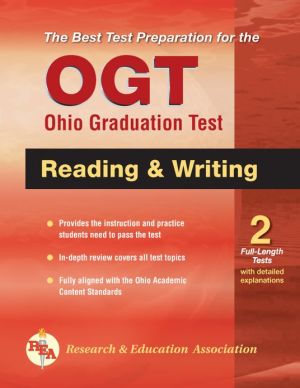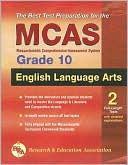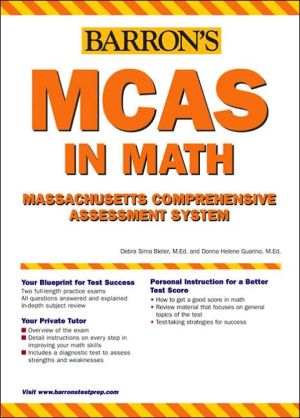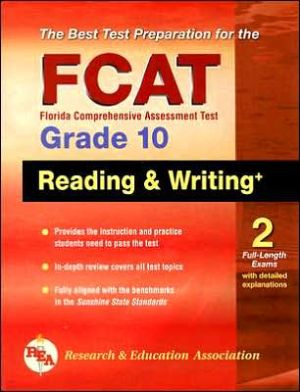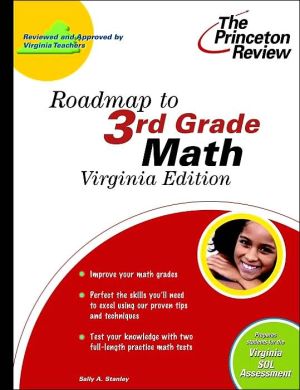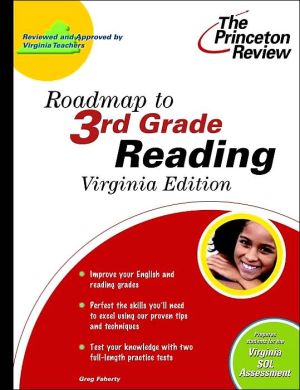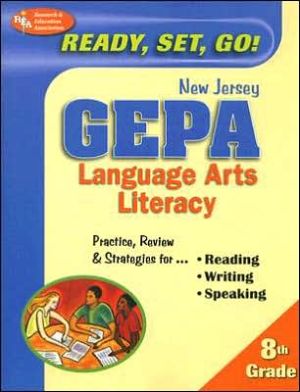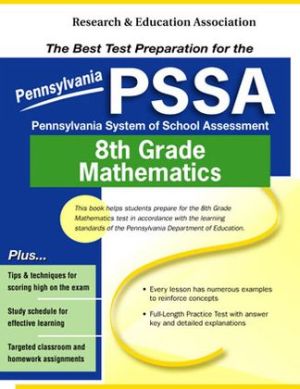OGT Reading and Writing, Ohio Graduation Test (REA)
REA Real review, Real practice, Real results.\ \ REA's Ohio OGT Reading & Writing Study Guide!\ Fully aligned with Ohio's Academic Content Standards\ \ Are you prepared to excel on this state high-stakes assessment exam? \ * Passing the exam is required to receive a high school diploma\ * Take the first practice test and find out what you know and what you should know\ * Use REA's advice and tips to ready yourself for proper study and practice\ \ Sharpen your...
Search in google:
REA … Real review, Real practice, Real results. REA's Ohio OGT Reading & Writing Study Guide!Fully aligned with Ohio's Academic Content Standards Are you prepared to excel on this state high-stakes assessment exam? * Passing the exam is required to receive a high school diploma* Take the first practice test and find out what you know and what you should know* Use REA's advice and tips to ready yourself for proper study and practice Sharpen your knowledge and skills* The book's full subject review refreshes knowledge and covers all topics on the official exam, including vocabulary, reading skills and strategies via interpreting, evaluating, and analyzing a wide variety of texts* Smart and friendly lessons reinforce necessary skills* Key tutorials enhance specific abilities needed on the test* Targeted drills increase comprehension and help organize study* Color icons and graphics highlight important concepts and tasks Practice for real* Create the closest experience to test-day conditions with two full-length practice tests* Chart your progress with detailed explanations of each answer* Boost confidence with test-taking strategies and focused drills Ideal for Classroom, Family, or Solo Test Preparation! REA has helped generations of students study smart and excel on the important tests. REA’s study guides for state-required exams are teacher-recommended and written by experts who have mastered the test.
Passing the Ohio Graduation Test (OGT) in Reading and Writing About This Book This book will provide you with accurate and complete representation of the Ohio Graduation Test (OGT) in reading and the OGTin writing. Inside are reviews designed to give you the information and strategies you need to do well on these tests. Fourpractice tests are provided, two based on the official OGT in reading and two based on the official OGT in writing. Thepractice tests contain every type of question you can expect to encounter on the actual tests. Following each practice testis an answer key with detailed explanations to help you completely understand the test material.\ About the Test Who Takes These Tests, and What Are They Used For?\ The OGT is given to all students throughout Ohio beginning in the spring of students' tenth-grade year. It is given to ensurethat graduating students have mastered essential core academic content and skills. The test is given in five content areas:reading, writing, mathematics, science and social studies. Students who do not pass the OGT in the tenth grade will have fourmore opportunities to retake and pass the OGT before the end of their twelfth-grade year.\ The OGT measures achievement in the skills and competencies outlined in Ohio's Academic Content Standards. The OGT inreading and OGT in writing measure achievement specifically according to the state's English Language Arts (ELA) AcademicContent Standards. The OGT ensures that all graduating students demonstrate at least a tenth-grade proficiency in all fivecontent areas. Students must pass each test to earn a high school diploma. A student who does not pass all five tests canstill earn a diploma if he or she meets all the following requirements:\ Passed four of the five tests and missed passing the fifth test by no more than 10 points\ Has a 97 percent attendance rate (excluding excused absences) for all four years of high school and no expulsion inhigh school\ Has a grade point average of 2.5 out of 4.0 in the subject area missed and completed the curriculum requirement inthe subject area missed\ Has participated in any intervention programs offered by the school and has a\ 97 percent attendance rate in any program offered outside the normal school day\ Obtains letters of recommendation from each teacher in the subject area not missed Is There a Registration Fee?\ No. Because all Ohio public and community or nonchartered high school students are required to take the OGT and pass thetests to receive a high school diploma, no fee is required.\ When and Where Is the Test Given?\ The OGT is first administered to Ohio high school students in the spring of their tenth-grade year. Makeup testing is offereda week after administration. Students will have several opportunities to take the OGT in each content area before the end oftheir twelfth-grade year. Tests are administered as follows:\ Spring of tenth grade\ Summer between tenth and eleventh grades (optional)\ Fall and spring of eleventh grade\ Summer between eleventh and twelfth grades (optional)\ Fall and spring of twelfth grade Test Accommodations and Special Situations Every student in Ohio must take the OGT or an alternative assessment. Every effort is made to provide a level playing fieldfor students with disabilities taking the OGT and seeking a standard high school diploma. Accommodations are made forstudents who meet certain criteria, such as students with disabilities or limited English proficiency.\ A student with significant cognitive disabilities and whose Individual Education Plan requires the student to take adifferent test can take the OGT Alternate Assessment for Students with Disabilities. This test measures achievement based oncriteria that reflect the achievement of the individual student. For more information about accommodations and the OGTAlternate Assessment, go to the Ohio Department of Education website atwww.ode.state.oh.us/proficiency/Alternate_Assessment/default.asp. Students can also ask questions of their school counselors.\ Additional Information and Support Additional resources to help you prepare to take the OGT can be found on the Ohio Department of Education website atwww.ode.state.oh.us/proficiency/OGT/OGT_Website_for_\ Students.asp.\ How to Use This Book What Do I Study First?\ Read over the review sections and the suggestions for test taking. Studying the review sections thoroughly will reinforce thebasic skills you need to do well on the test. Be sure to take the practice tests to become familiar with the format andprocedures involved with taking the actual OGT.\ When Should I Start Studying?\ It is never too early to start studying for the OGT. The earlier you begin, the more time you will have to sharpen yourskills. Do not procrastinate! Cramming is not an effective way to study, because it does now allow you the time needed tolearn the test material. The sooner you learn the format of the exam, the more time you will have to familiarize yourselfwith its content.\ Format of the OGT Overview of the OGT The OGT in reading and writing are designed to test students' abilities to read and write, and also tests their knowledge ofbasic literary concepts and familiarity with basic writing strategies. The OGT in reading requires students to answerthirty-two multiple-choice questions, four short-response questions and two extended-response questions on the readingprocess, reading application and vocabulary. Passages on this test may be literary or informational.\ The OGT in writing requires students to compose essays in response to two writing prompts and to answer tenmultiple-choice questions and one short-response question on the writing process.\ Scoring of the OGT On the OGT in reading, each multiple-choice question is worth 1 point, each short-response question is worth 2 points, andeach extended-response question is worth 4 points, for a total of 38 items and 48 possible points.\ Student responses on the OGT in writing are assessed by two readers. Each reader assigns a score of 0 to 6 forwriting applications and a score of 0 to 3 for writing conventions. The scores assigned by each reader are then addedtogether. Because students are required to respond to two writing prompts, a total of 36 points may be achieved on thewriting prompt portion of the OGT in writing. Additionally, each multiple-choice question is worth 1 point, and theshort-response question is worth 2 points, for a total of 13 items and 48 possible points.\ Test-Taking Strategies What to Do Before the Test\ Pay attention in class.\ Carefully work through the review sections of this book. Mark any topics that you find difficult so you can focus onthem while studying and get extra help if necessary.\ Take the practice tests and become familiar with the format of the OGT. When you are practicing, simulate theconditions under which you will be taking the actual test. Stay calm and pace yourself. After simulating the test only acouple of times, you will feel more confident, and this will boost your chances of doing well.\ You can relieve test anxiety, build confidence, and increase test success by being well prepared. A lot of testanxiety and stress will go away if you keep up with homework assignments and class work. Then, you can focus on the test witha clearer, more confident mind. It will help to talk to your parents and teachers if you are feeling nervous about this testor tests in general. They may be able to suggest some useful strategies to help you feel more relaxed so you can do your beston tests.\ What to Do During the Test\ Read all the possible answers. Just because you think you have found the correct response, do not automaticallyassume that it is the best answer. Read through each answer choice to be sure that you are not making a mistake by jumping toconclusions.\ Use the process of elimination. Go through each answer to a question and eliminate as many of the answer choices aspossible. By eliminating two answer choices, you will give yourself a better chance of getting the item correct, because youwill have only two other choices to choose from.\ Work quickly and steadily, and avoid focusing on any one question for too long. Taking the practice tests in thisbook will help you learn to budget your time on the actual test.\ Work on the easiest questions first. If you find yourself working too long on one question, make a mark next to it onyour test booklet and continue. After you have answered all the questions you know, go back to the ones you skipped.\ Be sure that the answer oval you are marking corresponds to the number of the question in the test booklet. Becausethe multiple-choice sections are graded by machine, marking one wrong answer can throw off your answer key and your score. Beextremely careful.\ Work from the answer choices. You can use a multiple-choice format to your advantage by working backward from theanswer choices to answer the question. You may be able to make an educated guess after eliminating choices that you know donot fit the question. Benchmarks of the OGT ChaptersBenchmarksChapter 1: Vocabulary, Part 1Acquisition of Vocabulary A.\ Use context clues and text structures to determine the meaning of new vocabulary.\ D.\ Explain how different events have influenced and changed the English language.\ E.\ Apply knowledge of roots and affixes to determine the meanings of complex words and subject-area vocabulary.\ Grade Level Indicators\ 1.\ Define unknown words through context clues and the author's use of comparison, contrast and cause and effect.\ 4.\ Examine and discuss ways historical events have influenced the English language.\ 5.\ Use knowledge of Greek, Latin and Anglo-Saxon roots, prefixes and suffixes to understand complex words and new subject-areavocabulary (e.g., unknown words in science, mathematics, social studies).\ Chapter 2: Vocabulary, Part 2Acquisition of Vocabulary C.\ Recognize the importance and function of figurative language.\ Grade Level Indicators\ 3.\ Infer the literal and figurative meanings of words and phrases and discuss the function of figurative language, includingmetaphors, similes, idioms and puns.\ Reading Applications: Literary Text F.\ Identify and analyze how an author uses figurative language, sound devices and literary techniques to shape plot, set meaningand develop tone.\ Grade Level Indicators\ 7.\ Recognize how irony is used in a literary text.\ 8.\ Analyze the author's use of point of view, mood and tone.\ 9.\ Explain how authors use symbols to create broader meanings.\ 10.\ Describe the effect of using sound devices in literary texts (e.g., to create rhythm, to appeal to the senses or to establishmood).\ 11.\ Explain ways in which an author develops a point of view and style (e.g., figurative language, sentence structure and tone),and cite specific examples from the text.\ Chapter 3: Main Idea, Theme and Supporting DetailsReading Process: Concepts of Print, Comprehension Strategies and Self-Monitoring Strategies A.\ Apply reading comprehension strategies to understand grade-appropriate text.\ Grade Level Indicators\ 1.\ Apply reading comprehension strategies, including making predictions, comparing and contrasting, recalling and summarizing,and making inferences and drawing conclusions.\ Reading Applications: Literary Text E.\ Analyze the use of a genre to express a theme or topic.\ Grade Level Indicators\ 6.\ Analyze how an author's choice of genre affects the expression of a theme or topic.Chapter 4: Evaluating InformationReading Process: Concepts of Print, Comprehension Strategies and Self-Monitoring Strategies A.\ Apply reading comprehension strategies to understand grade-appropriate text.\ B.\ Demonstrate comprehension of print and electronic text by responding to questions (literal, inferential, evaluative andsynthesizing).\ Grade Level Indicators\ 1.\ Apply reading comprehension strategies, including making predictions, comparing and contrasting, recalling and summarizing,and making inferences and drawing conclusions.\ 2.\ Answer literal, inferential, evaluative and synthesizing questions to demonstrate comprehension of grade-appropriate printtexts and electronic and visual media.\ Chapter 5: Author's PurposeReading Applications: Informational, Technical and Persuasive Text B.\ Identify examples of rhetorical devices and valid and invalid inferences, and explain how authors use these devices toachieve their purposes and reach their intended audiences.\ D.\ Explain and analyze how an author appeals to an audience and develops an argument or viewpoint in text.\ Grade Level Indicators\ 4.\ Assess the adequacy, accuracy and appropriateness of an author's details, identifying persuasive techniques (e.g., bandwagon,testimonial, transfer, glittering generalities, emotional word repetition, bait and switch) and examples of propaganda, biasand stereotyping.\ 5.\ Analyze an author's implicit and explicit argument, perspective or viewpoint in text.\ 6.\ Identify appeals to authority, reason and emotion.\ 8.\ Identify the features of rhetorical devices used in common types of public documents, including newspaper editorials andspeeches.\ Chapter 6: Literary TextsReading Applications: Literary Text A.\ Analyze interactions between characters in literary text and how the interactions affect the plot.\ C.\ Identify the structural elements of the plot and explain how an author develops conflicts and plot to pace the events inliterary text.\ Grade Level Indicators\ 1.\ Compare and contrast an author's use of direct and indirect characterization, and ways in which characters reveal traitsabout themselves, including dialect, dramatic monologues and soliloquies.\ 3.\ Distinguish how conflicts, parallel plots and subplots affect the pacing of action in literary text.\ 7.\ Explain how literary techniques, including foreshadowing and flashback, are used to shape the plot of a literary text\ 8.\ Recognize how irony is used in a literary text.\ Chapter 7: Nonfiction TextsReading Applications: Informational, Technical and Persuasive Text A.\ Evaluate how features and characteristics make information accessible and usable and how structures help authors achievetheir purposes.\ C.\ Analyze whether graphics supplement textual information and promote the author's purpose.\ Grade Level Indicators\ 1.\ Identify and understand organizational patterns (e.g., cause-effect, problem-solution) and techniques, including repetitionof ideas, syntax and word choice, that authors use to accomplish their purposes and reach their intended audiences.\ 3.\ Analyze information found in maps, charts, tables, graphs, diagrams, cutaways and overlays.\ 7.\ Compare and contrast the effectiveness of the features (e.g., format, sequence, headers) used in various consumer documents(e.g., warranties, product information, instructional materials), functional or workplace documents (e.g., job-relatedmaterials, memoranda, instructions) and public documents (e.g., speeches, newspaper editorials).\ Chapter 8: Writing an EssayWriting Applications C.\ Produce letters (e.g., business letters, letters to the editor, job applications) that follow the conventional styleappropriate to the text, include appropriate details and exclude extraneous details and inconsistencies.\ E.\ Write a persuasive piece that states a clear position, includes relevant information and offers compelling evidence in theform of facts and details.\ Grade Level Indicators\ 3.\ Write business letters, letters to the editor and job applications that do the following:\ a.\ Address audience needs, stated purpose and context in a clear and efficient manner\ b.\ Follow the conventional style appropriate to the text, using proper technical terms\ c.\ Include appropriate facts and details\ d.\ Exclude extraneous details and inconsistencies\ e.\ Provide a sense of closure to the writing\ 4.\ Write informational essays or reports, including research, that do the following:\ a.\ Pose relevant and tightly drawn questions that engage the reader\ b.\ Provide a clear and accurate perspective on the subject\ c.\ Create an organizing structure appropriate to the purpose, audience and context\ d.\ Support the main ideas with facts, details, examples and explanations from sources\ e.\ Document sources and include bibliographies\ 5.\ Write persuasive compositions that do the following:\ a.\ Support arguments with detailed evidence\ b.\ Exclude irrelevant information\ c.\ Cite sources of information Writing Conventions A.\ Use correct spelling conventions.\ B.\ Use correct punctuation and capitalization.\ C.\ Demonstrate understanding of the grammatical conventions of the English language.Grade Level Indicators\ 1.\ Use correct spelling conventions.\ 2.\ Use correct capitalization and punctuation.\ 3.\ Use clauses (e.g., main, subordinate) and phrases (e.g., gerund, infinitive, participial).\ 4.\ Use parallel structure to present items in a series and items juxtaposed for emphasis.\ 5.\ Use proper placement of modifiers.
Contents About Research & Education Association Acknowledgments Passing the Ohio Graduation Test (OGT)\ in Reading and Writing About This Book About the Test How to Use This Book Format of the OGT Test-Taking Strategies Benchmarks of the OGT Section 1: Reading Chapter 1: Vocabulary, Part 1\ Deriving Meaning Context Clues Word Structure Passage 1:\ Departure (excerpt from Winesburg, Ohio)\ Passage 2: Annabel Lee Passage 3: The Six Nations of the Iroquois Passage 4: Curious Crop Circles Answers and Explanations Chapter 2: Vocabulary, Part 2\ Author's Word Choice Tone and Mood Passage 1: The Man He Killed Passage 2:\ Excerpt from Up from Slavery:\ An Autobiography Passage 3: William Shakespeare: Poet and Playwright Passage 4: Excerpt from "The False Gems"\ Answers and Explanations Chapter 3: Main Idea, Theme and Supporting Details Main Idea Theme Supporting Details Passage 1: Excerpt from "The Yellow Wallpaper"\ Passage 2: The Coolest Invention Passage 3: The Thinking Spot Passage 4: John Mercer Langston: Ohio Abolitionist Answers and Explanations Chapter 4: Evaluating Information How Do You Evaluate Information?\ Passage 1:\ Safe at Sixteen? Why We Should Raise the Legal Driving Age Passage 2:\ American Aid Essential for First-Rate Foreign Relations Passage 3: Lively Lizards: The Colorful Chameleon Passage 4:\ Carbohydrate Craze: Carb-Free Is Unhealthy Answers and Explanations Chapter 5: Author's Purpose Why Do Authors Write?\ Passage 1: Unwinding Our Minds Passage 2: Tarantula Tamer Passage 3: Don't Sweat Global Warming Passage 4: The Truth About Year-Round Education Answers and Explanations Chapter 6: Literary Texts Literary Elements Conflict and Resolution Characterization Passage 1: Ah, Are You Digging on My Grave?\ Passage 2: Ripe Figs Passage 3: Excerpt from Hamlet Passage 4: Excerpt from "The Hypnotist"\ Answers and Explanations Chapter 7: Nonfiction Texts Reading and Understanding Nonfiction Passage 1: Fuel of the Future Passage 2: Daydreams Save the Day Passage 3:\ A Rose by Any Other Name: The Debate over the "Real" Shakespeare Passage 4: MP3: Decompressed Answers and Explanations Section 2: Writing Chapter 8: Writing an Essay Introduction OGT Writing Prompts Developing Your Essay How Essays Are Graded Sample Essays Chapter 9: Revising and Editing Introduction\ Hints for Taking the Multiple-Choice and Short-Response Portions of the OGT in Writing Revision Practice for the OGT in Writing Answers and Explanations Practice Test 1: Reading Practice Test 1: Writing Answers and Explanations: Reading Answers and Explanations: Writing Practice Test 2: Reading Practice Test 2: Writing Answers and Explanations: Reading Answers and Explanations: Writing Answer Sheets Answer Key Index Photo Credits
